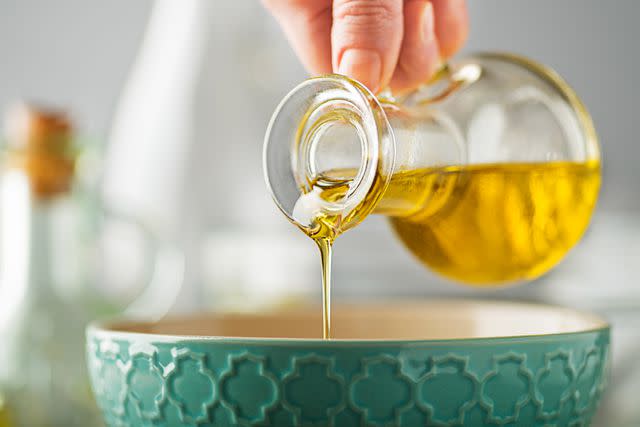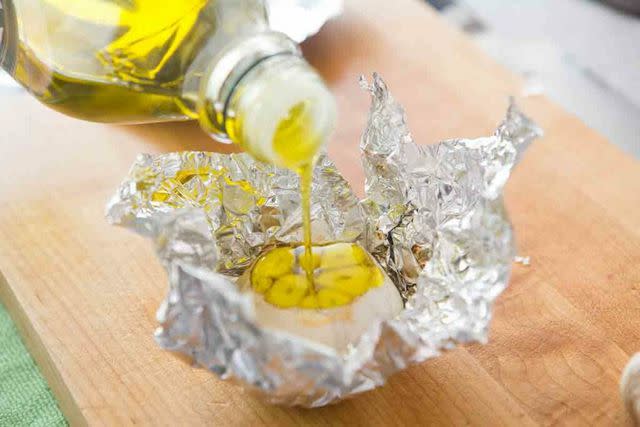Extra Virgin Olive Oil vs. Regular Olive Oil: Experts Explain the Difference
The more expensive one isn't always the best.

Simply Recipes / Getty Images
Back in my teens when I started cooking for myself, you could find a maximum of maybe three types of olive oil in the average American grocery store. Now, even the most basic supermarket has dozens of choices, designations like "unrefined" or "refined," "extra virgin," "light tasting," and "cold pressed" on the front or back label.
It's confusing even for someone who works in food like me! So, I consulted two experts: Joseph R. Profaci, executive director of the North American Olive Oil Association, and Olivia Roszkowski, chef-instructor of Plant-Based Culinary Arts at the Institute of Culinary Education. Here's what I learned.
What Is Extra Virgin Olive Oil?
Extra virgin olive oil is made by mechanically pressing raw, uncured olives to extract the oil. To be designated as extra virgin, no heat or chemicals can be used during the extraction process or at any other stage of getting it into the bottle.
In certain countries, extra virgin olive oil (but not virgin olive oil) must contain low levels of unsaturated fatty acids and come from the first milling of the freshly harvested olives, Roszkowski explains.
Roszkowski says that extra virgin olive is usually a deeper green tone than refined olive oil because it is less processed so it retains more of the natural olive color qualities. That said, some good-quality extra virgin olive oils are pale yellow.
Extra virgin olive oil typically has a bold taste that can be fruity, herbaceous, buttery, peppery, grassy, or citrusy, to name just a few common flavor profiles. It is known to be high in heart-healthy oleic acid and naturally occurring antioxidants and phenols, according to Profaci.
What Is Regular Olive Oil (aka Refined Olive Oil)?
The regular olive oil you find at the store—that is, olive oil that doesn't carry a virgin or extra virgin label—is typically a blend of virgin and refined oils, says Profaci. "When it comes to olive oils, if the label doesn’t say 'virgin,' then you can assume that it is [primarily] refined olive oil," he adds. Note that you won't usually see "refined" on the front of the label, although it's often on the ingredient list. If you see "light" or "light tasting" on a label, that also most likely means you're holding a bottle of refined olive oil.
Regular olive oil is extracted from the olive fruit without the use of chemical solvents or heat, but it is then refined.
"The process involves physical and chemical treatments that involve heat and pressure, as well as purification with sodium hydroxide (which is the chemical used by municipal water facilities to purify our drinking water)," Profaci explains.
Refined olive oil is typically milder in flavor and lighter in color than extra virgin olive oil, Roszkowski says. It also has a higher smoke point, which makes it more suitable for high-heat cooking, such as deep frying, than virgin olive oil, she adds. And although refined olive oil is also known to be high in heart-healthy oleic acid, it has fewer antioxidants and phenols, says Profaci.
Refined olive oil tends to be more affordable and has a longer shelf life than extra virgin olive oil. Profaci adds that about 75% of olive oils sold are virgin—i.e., extra virgin—and 25% are refined.

Simply Recipes / Andrew Christensen
When Is It Best To Use Extra Virgin vs. Regular Olive Oil?
Roszkowski says extra virgin olive oil is great for when you want a strong olive taste. "Keep a bottle on hand for dipping in crusty bread, as a finishing oil over dips like hummus, or even in desserts like olive oil gelato or olive oil cake."
Refined olive oil might be a better choice when you want a neutral flavor, such as in marinades and when roasting vegetables or proteins, Roszkowski says.
"When making an infused herb oil such as chive, sage, parsley, or basil, using refined olive oil is a good way to allow the delicate volatile aromatic compounds of the herbs to shine without compromising the spotlight," she adds.
She also recommends using refined olive oil if you plan to heat it to a high temperature, like for deep frying.
The smoke point for extra virgin olive oil is 400°F, but Profaci says that research published in ACTA Scientific Nutritional Health indicates that extra virgin olive oil can be used at even higher temperatures, such as for baking and frying, without breaking down.
Roszkowski says you can use either in pesto, pasta salad, salad dressing, pizza, or bread doughs, and when making pasta dough. Both experts agree that in many cases it comes down to personal preference or what you have on hand.
The price might also determine which is best since extra virgin olive oil tends to be pricier than refined olive oil—a good reason not to deep fry your turkey in extra virgin olive oil because you'd need a lot of it.
In addition to flavor preferences, smoke point, and budget, which olive oil you choose comes down to the importance you place on its health benefits. While all olive oil is known to be healthy, Profaci says that extra virgin olive oil has a distinct advantage.

The Takeaway
Regular olive oil is extracted and processed, and it has a lighter color and taste than extra virgin olive oil. It's a great choice when you want a milder flavor or are cooking at very high temperatures.
Extra virgin olive oil is extracted from fresh olives without the use of heat or chemicals and then bottled without additional processing. When you're looking for an olive oil that's full of flavor, as well as compounds that may benefit your health, reach for the extra virgin olive oil.
Read the original article on SIMPLYRECIPES


